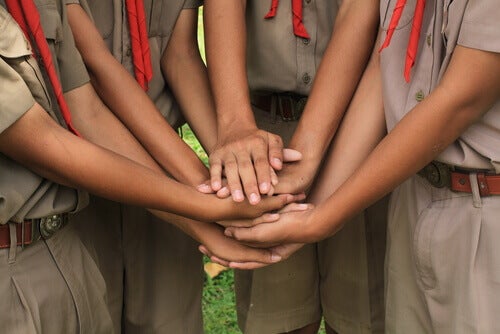The experience of thieves‘ caverns is one of the most classic in the field of social psychology, held in 1945 at the initiative of Muzafer Sherif and Carolyn Sherif, professors at the University of Oklahoma (USA). U. S. A. ). Identify some points that allow a better understanding of social prejudices.
The experience of the cave of thieves focused on the concept of “group”. The attempt was to visualize how perception of belonging to a particular group is formed, how relationships within it are configured, and how one group relates to others.
“Prejudice is pre-compliance sentences. -José Ingenieros-
Another objective was to identify how the conflict between groups arises or intensifies, when there are two groups in which its members have developed a strong sense of belonging to the group, it seems that at the same time, it is common to increase the rejection of non-membership groups and the characteristics that identify these groups. At the same time, this can be reversed. Let’s see how this interesting study was conducted.
To conduct the study, the researchers chose 22 11-year-olds. They were all “normal” kids. This means they had no history of misbehavior, came from stable families, and performed well in school. They were all middle-class kids and none of them knew they were taking part in an experiment.
Once the selection was made, the children were randomly divided into two groups, then went to participate in a summer championship, in an area of Oklahoma known as Thief’s Cave National Park, both groups camped in remote locations, neither of the children knew. that the other group existed.
The experience of the cave of thieves was divided into three phases: in the first, the researchers tried to stimulate the feeling of belonging to the group, the second was the friction phase, in which situations were deliberately created to generate conflicts between a group and The final phase was integration, in which researchers tried to resolve conflicts and reduce apparent differences.
During the first week, activities were developed to consolidate internal relationships in each group, the boys went for a walk together, swimming in the group’s pool and performing various recreational activities, each group was asked to choose a name and symbol. They called themselves the groups? And the other ‘rattlesnakes’.
In this first phase it was observed that the members of each group identified with their own group and developed a strong sense of belonging, in a few days different hierarchies and internal roles emerged in each group, the bonds between the members gradually strengthened in each group. Camping.
In the second week, both groups learned of each other’s existence. From the beginning, each group was defensive compared to the other. The barriers were obvious. It was the boys themselves who asked the researchers to carry out competitive activities between the two groups, they did so and even offered an award to the winning group, which ended up being ‘Rattlesnakes’.
Since then, hostility has increased markedly. Friction became frequent, reaching the point where the boys refused to eat together in the same place, mutual rejection increased so much that investigators decided to finish this phase earlier than they had originally anticipated, fearing that the confrontational situation would become uncontrollable.
Those responsible for the cave experiment of thieves have shown that the sense of belonging and prejudice against the different go hand in hand, and realized how easy it was to reinforce the sense of belonging to a group and generate hatred between the two.
In the final phase, researchers developed activities that required the cooperation of both groups, one of which was to create a fictitious problem. They told the children that the water supply had run out due to some vandalos (common external enemy). Children were supposed to solve the supply problem. To do this, the two groups worked together.
Subsequently, the researchers said they would show a film that almost all the boys liked, but would have to pay for the screening, none of the groups managed to reach the required amount and again had to cooperate to achieve the common goal.
After solving several problems together, mutual antipathy disappeared, at this point on the way back both groups asked to take the same bus, when they stopped to rest, the group?Rattlesnakes? He used the money earned during the competition to buy soft drinks for the 22 boys.
Investigators in the cave of thieves concluded that establishing common problems and, in turn, common goals was a way to resolve conflicts between groups. The researchers called the study “realistic theory of conflict. “They indicate that the common resolution of a common problem gradually reduces prejudice until they disappear.

